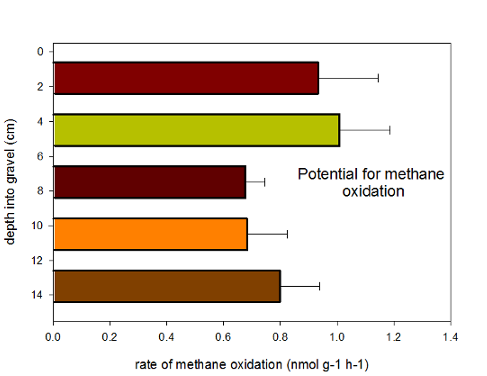Introduction
Using simple incubation experiments in the lab, we have demonstrated that chemosynthesis may contribute the equivalent of 6% of the photosynthetically fixed carbon in gravels from these rivers (Trimmer et al 2010). We hypothesised that the relative importance of methane-derived carbon would actually increase under the shade of in-stream vegetation, down into the hyporheos, and in winter due to lower photosynthetic production.
Substrate limitation of methanotrophy

Although chalk rivers are almost always oversaturated with methane, laboratory incubations have revealed that the methanotrophic communities in chalk rivers are substrate limited at riverine concentrations.
Our survey work shows the dissolved methane in English chalks rivers varies spatially and temporally between 20nmol L-1 and 500nmol L-1 with the highest concentrations always observed in the summer.
We can measure methane oxidation within these concentrations but when we raise the concentration of methane we observe an increased rate of oxidation. Indeed, we have seen a linear increase in rate of methane oxidation with increasing methane up to 5000nmol L-1, some 50 times higher than the average concentrations encountered in situ!
Figure 1 - Substrate limitation of methanotrophy.
The efficiency of carbon fixation coupled to methane oxidation in chalk streams

To better quantify the amounts of methane-derived carbon being fixed as biomass and respired, Susanna Maanoja has been determining the efficiency of carbon fixation by using stable carbon isotope labelling of the methanotrophs which are associated with the biofilm of the chalk stream gravels for her Aquatic Ecology by Research MSc thesis.
She collected gravels from the Lambourn and Mimram, which are typical groundwater-fed chalk streams in Southern England. In lab incubations, 13C-CH4 was given to methanotrophs as a substrate and the fate of the metabolised 13C was traced by CF-IRMS. The most challenging part was to establish methods to remove and analyse the biofilm from gravels of all sizes (lipid extraction (Fig 1 ) and oxidation of total organic carbon) to determine the amount of 13C assimilated into the biomass of methanotrophs.
The methanotrophs oxidised methane at rates comparable to those measured from peat-bogs and rice paddy fields. The gradual increase in the δ13C values of lipids (Fig 2) revealed that the methane-derived 13C was assimilated into biomass.
The efficiency of carbon fixation by methanotrophs was calculated from the amount of 13C assimilated into the total organic carbon fraction of the biomass associated with gravel-biofilm. We will use Susanna’s results to estimate the productivity of methanotrophic bacteria and to quantify the contribution of chemoautotrophic primary production to the total production of new carbon in the ecosystem.
Figure 2 - 13C enrichment of lipids with time (samples with 13CH4) relative to the controls (samples with 12CH4).
What is the effect of light availability and methane concentration on the significance of methane-derived carbon to river food webs?
Through a combination of field surveys and lab-based experimentation, Felicity Shelley is starting to address this question. Using gas chromatography, chlorophyll extraction techniques and oxygen microsensors, she has been quantifying the relative significance of photosynthetic and chemosynthetic basal resources in the Lambourn hyporheos.


Figure 3 - Changing potential for methane oxidation and photosynthesis down into the Lambourn hyporheic.
From the example figures above, it is clear that methane oxidative potential does become more significant with depth relative to photosynthetic carbon fixation. Furthermore, the biofilm is temporally and spatially heterogeneous and responds dynamically to nutrient loadings, methane concentrations, and light availability.
Felicity will artificially manipulate the light availability to natural stream patches in order to assess the speed at which the biofilm adapts to increased shading and how the chemosynthetic communities react to this physical change. The site for much of this work is the Bere Stream in Dorset. There are obvious parallels here to the replicated channel experiment










